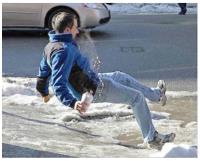 Add My Company
Add My Company
Sign In
DON’T SLIP UP
04-10-2018

Don’t Slip Up
As temperatures continue to remain at freezing across the UK, hospitality and leisure managers armed with large bags of grit and salt, are clearing paths and making safe their common areas. Whilst such acts of safety are done with the best intentions, the responsibilities and obligations of doing so are far more complicated than you might expect. In truth a simple act of kindness can in fact have detrimental implications if somebody was to slip or fall, but failing to act properly can be equally damaging – it is a complicated matter that is best discussed with legal personnel or your insurers.
In an effort to see through the blizzard of red tape, NDML offer the following advice.
Note: Detailed records of all common area safety precautions e.g. gritting must be made and kept – without such records insurance companies might not provide indemnity. In addition, a claimant has 3 years in which to pursue a claim; records therefore need to be kept for at least that period.
Just who is responsible for different parts/types of common areas? And for how much?
The ownership and responsibility for maintaining common parts of property are often not completely clear, with many considerations to take into account. The responsibilities are further confused by the Occupiers’ Liability Act, which can theoretically see either the landlord or the tenant, or both, defined as the legal occupier of a property in the event of a claim.
Landlords’ Obligation under a Property’s Lease
It’s common for a landlord to retain ownership of part of an estate when leasing to tenants, although this is less likely if the property is let as a whole to one tenant.
Ambiguity as to who is responsible arises when there are parts of an estate that are retained in the ownership of landlords – known as estate areas or common parts. This is likely where there will be more than one tenant using these estate areas. In such cases, landlords will retain control of the estate areas and grant tenants a right of way.
While a standard lease is unlikely to contain any reference to ice and snow clearance as a specific service, it is generally the case that the lease will contain a ‘sweeper’ clause. This type of clause will oblige a landlord to provide services of any kind in the interests of good estate management. Whether the management of ice and snow can fall under such a clause depends very much on an individual basis
If a landlord has granted a right of way to the tenant (and more than likely also their visitors and employees) over the estate areas, then there will be an obligation to ensure that the right of way can be exercised safely. That said, this doesn’t mean that a landlord has to clear every inch of every possible route of access. Case law sets out that landlords aren’t liable for someone who may have an accident in a car park, for example if they have put a reasonable system to clear access routes in place.
However, effectively gritting and clearing all access routes could be a particularly onerous task, one which a landlord will struggle to maintain. A practical solution would be for a landlord to facilitate the removal of snow by providing the tenant with the necessary equipment, along with a regularly restocked grit bin. The landlord would need to enter into an agreement with the tenant, who may seek payment for the provision of the service – although this could potentially be recoverable through the service charge.
Tenant obligations
Where a property is let as a whole to a tenant, then it is unlikely that the landlord will have any service obligations in the lease. In such cases, repair and maintenance is likely to be the responsibility of the tenant. While there may be no specific mention of snow and ice clearing responsibilities in a lease of this kind, the general maintenance obligations are likely to cover such works.
Indeed, where a landlord is not responsible for the clearance of ice and / or snow, the tenant may legally be. In commercial premises the responsible tenant should be mindful of employees and visitors. A commercial lease will often require compliance with statutory obligations in relation to the premises including those set out in the Health and Safety At Work Etc Act 1974 (which deals with a plethora of issues in addition to property and whilst considered relevant is not discussed in this article) and the Occupiers’ Liability Act 1957 (the “Act”).
Obligations under the Occupiers Liability Act
The main threat of legal challenge following an accident or injury occurring on a property comes from the Occupiers’ Liability Act, even if not obliged to clear snow and / or ice under a property’s lease, a landlord or tenant may still find themselves legally liable under the Act.
Furthermore, the responsibilities of landlords and tenants are actually further confused by the Act (see details below). It imposes a duty on the ‘occupier’ of a property to take reasonable care in all the circumstances to ensure that visitors are safe when using the premises for purposes which they have been invited to do or permitted by the occupier to do.
However, the term ‘occupier’ is not defined in statute, with courts instead deciding on who is the occupier on a case-by-case basis, based on the individual facts of the case in question. Exclusive possession of a property is not required for a party to be determined as the occupier. The test is whether a party has some degree of control associated with and arising from his presence in and use of or activity in the premises .
The courts have previously found a landlord, tenant, contractor and even a concessionaire to be deemed ‘occupier’ for the purposes of the Act. It is important to note that two parties can be the relevant ‘occupier’ at the same time if a sufficient degree of control can be attributed to both.
Public Highways
Occupiers, whether defined as landlord or tenant, are under no obligation to clear ice and snow from public highways surrounding their property. It is the reasonability of local authorities to clear public highways as far as is “reasonably practicable” (see below).
However, in many cases, if the local authority has not already done so, occupiers of premises may wish to clear areas of public highway in front of their premises, in order to allow access. Ironically, the very act of helping to clear areas of snow and ice is seen as a risk by many landlords and tenants. This is a paradoxical fear that such acts can leave people open to risk of blame for any injuries or accidents that subsequently may occur where the individual has undertaken clearing work.
The main legislations and legalities that landlords need to be aware of in the event of an accident (Key definitions from the Occupiers Liability Act, Service charge provisions etc.)
Highways Act: Section 41 (1A) of the Act sets out the local authorities duties to clear public highways where “reasonably practicable”. The snow code: Direct gov’s guide to clearing ice and snow safely can be found here: https://www.gov.uk/clear-snow-road-path-cycleway
Occupiers’ Liability Act 1957 Section 2 – Extent of occupier’s ordinary duty:
(1) An occupier of premises owes the same duty, the “common duty of care”, to all his visitors, except in so far as he is free to and does extend, restrict, modify or exclude his duty to any visitor or visitors by agreement of otherwise.
(2) The common duty of care is a duty to take such care as in all the circumstances of the case is reasonable to see that the visitor will be reasonably safe in using the premises for the purposes for which he is invited or permitted by the occupier to be there.
What steps can landlords take to protect themselves proactively and reactively (Who to contact, what to do following a claim, issues over insurance coverage, advice on whether costs can be passed on.)
Protect yourself from blame under the Occupiers’ Liability Act
Given the uncertainty surrounding the occupancy of a property under the Occupiers’ Liability Act, landlords, and, indeed, tenants, should not simply assume that the other party should be the party responsible for taking sufficient steps to clear snow and / or ice. Rather, they should take legal advice as to their potential liability under the Act and, if advised, take steps to make the premises safe.
Furthermore, under Section 4(1) of the Act the occupier can absolve themselves from liability if visitors are warned of the danger of, for example, slipping on ice. Although a prominent sign making the potential danger clear is the most likely warning that occupiers will use, in most cases signage alone is unlikely to be sufficient. As well as clearly informing visitors of the potential danger, an occupier should also take steps to clear the ice and / or snow.
Follow the advice of the Health and Safety Executive (HSE)
To reduce the risk of trips and slips on ice, frost or snow, the HSE advises that a business needs to assess the risk and put a system in place to manage it. It is suggested that you must:
Identify the outdoor areas used by pedestrians most likely to be affected by ice;
Monitor the temperature, and take preventative measures
Put a procedure in place to prevent an icy surface forming and/or keep pedestrians off the slippery surface; and
If warning cones are used, remember to remove them once the hazard has passed or they will eventually be ignored.
Passing on charges
In cases where landlords incur charges clearing ice and snow as part of ‘sweeper’ clause obligation, the costs may be recoverable through the service charge.
Furthermore, as discussed above, any charges incurred making arrangements to clear access paths could also potentially be recovered through the service charge.
In Summary
Landlords and tenants need to consider their lease terms and, if appropriate, seek legal advice to ascertain whose responsibility it is to take steps to ensure the premises are safe. Even if it is established that no duty is imposed by the lease, advice should be sought regarding the possibility that obligations exist under Statute.
Whilst there have been few reported cases under the Occupiers’ Liability Act involving snow / ice, the likely reason is that most claims settle before trial. As such, landlords and tenants must stay alert to the issues posed by bad weather conditions
For more information on DON’T SLIP UP talk to NDML Insurance Specialists
Enquire Now
List your company on FindTheNeedle.

